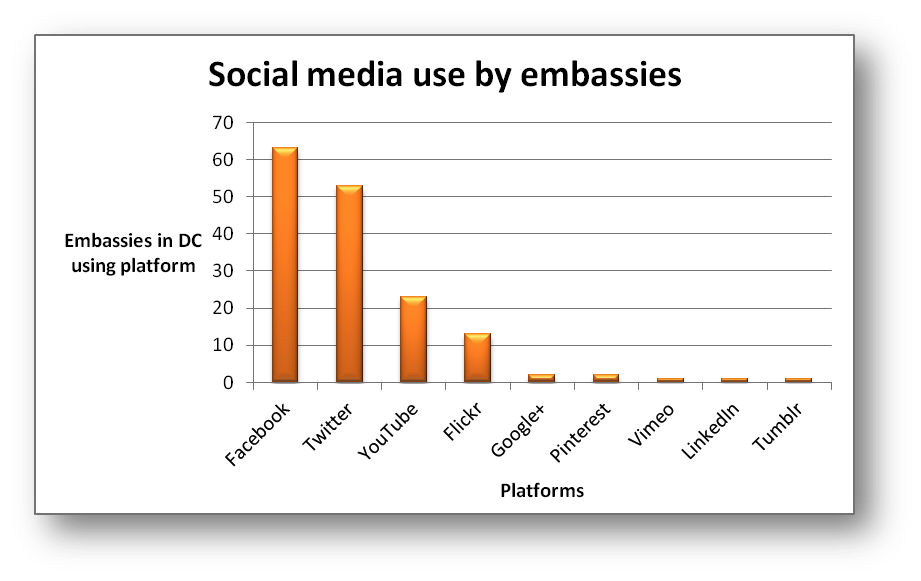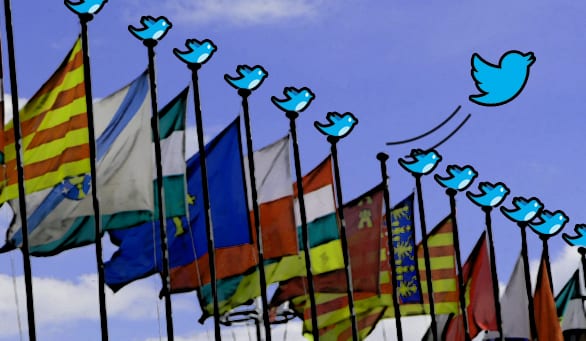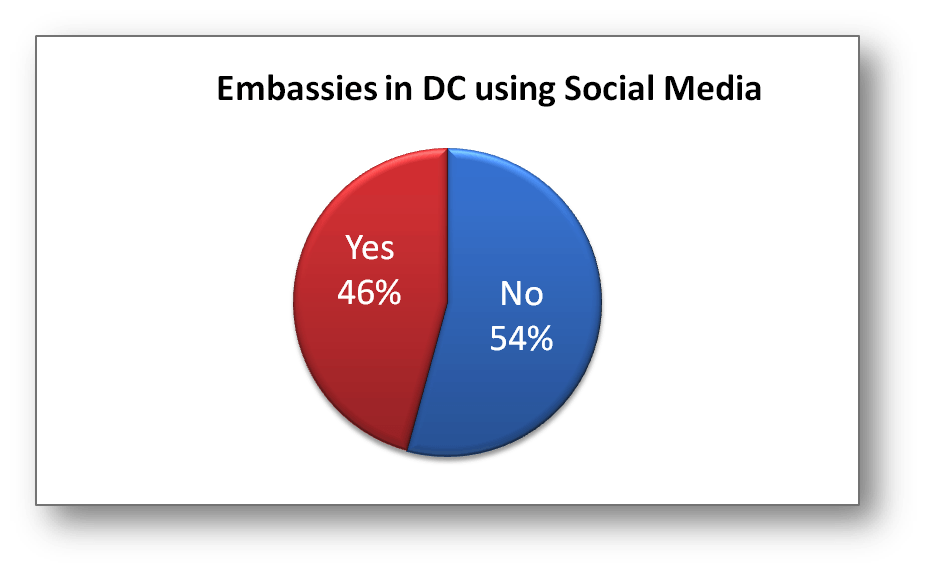This post was co-written by Dr. Ali Fisher, Associate Director, Intermedia. Ali produces analysis of social movements which enhances organisational strategy, strategic communication and evaluation through network analysis and big data. Current research includes the use of digital media during elections, and social media as an information sharing tool during moments of tension, in addition to projects focused on e-diplomacy strategy and methods to disrupt the use of the internet by violent extremists. Ali’s book Collaborative Public Diplomacy; How transnational networks influence American Studies in Europe was published earlier this year.
Social media is one of the fastest growing tools of modern public diplomacy. The advantage of social media provides the opportunity to reach citizens of other countries in near real-time. Social media platforms also provide spaces for interaction, increased engagement, and thus furthering the goals of public diplomacy. This research has been conducted by Jeanette Gaida as part of a capstone project for the Masters in Global Communication at George Washington University, working with Ali Fisher at InterMedia.
The potential ease with which social media can be accessed and the low cost in comparison to other methods make it an attractive tool for many embassies, as well as other government offices, that are facing budget cuts and demands to increase engagement. Numerous platforms allow for the use of more dynamic content, such as videos, photos, and links, than traditional methods of giving lectures or passing out pamphlets. In addition, social media are key channels in reaching youth populations, a major goal of current public diplomacy efforts.
However, public diplomacy is not only about reaching a youth audience. It is equally important to listen to and understanding young publics, their thoughts, aspirations, information seeking and sharing behaviors along with the actions they take as a result. With this insight, there is greater potential to engage and collaborate with key communities rather than broadcast to a target audience.
Which platforms are used to conduct e-diplomacy in Washington DC?
With over 170 diplomatic missions in the United States, American citizens and social media users around the world have a vast range of channels with which to engage. Adding to the range of channels, many embassies also have multiple accounts on the same platform, often an account representing the Ambassador and an account for the embassy.
To analyze the extent to which Embassies in DC are conducting e-diplomacy, accounts were identified through the websites of the respective embassies. An embassy was recorded as conducting e-diplomacy if the embassy website had easily identifiable links to social media accounts or if a brief, basic, search of social media platforms uncovered an account.
Which platforms are embassies in DC most frequently using to conduct e-diplomacy?
 Twitter and Facebook are the most popular platforms.
Twitter and Facebook are the most popular platforms.
Logically, some embassies will use more than one platform to conduct e-diplomacy. The research found that every embassy that uses more than one platform, use at least one of Facebook or Twitter as part of their e-diplomacy strategy.
Platform Usage Among Embassies
| More Than 1 Twitter | Both | Neither | Facebook and Not Twitter | Twitter and Not Facebook | |||
| Embassies using 2 platforms | 88% | 14% | 100% | 88% | 0% | 13% | 0% |
| Embassies using 3 or more platforms | 100% | 19% | 86% | 86% | 0% | 0% | 14% |
Total number of embassies using 2 platforms= 24
Total number of embassies using 3 or more platforms= 21
This overview of the data raises some important questions for further analysis:
- Which embassies are reaching the most users?
- Which Ambassadors or representatives are reaching the most users?
- Are embassies using the persona of an ‘Ambassador’ more frequently than ‘Embassy’ accounts?
- Do the same social media users engage with both an Ambassador and Embassy from the same country?
- Are individual or institutional accounts reaching more users?
- Are embassies engaging with the same people, or does each embassy engage a different group of social media users.
- If social media users are engaging with more than one embassy, what can we tell about these users?
An evidence based approach to e-diplomacy strategy:
To analyze the strategic implications of this data to inform the conduct of e-diplomacy, the capstone project will focus on five embassies to study in depth: the United Kingdom, Peru, India, Italy, and Sri Lanka. These accounts were chosen as they represent countries from a range of continents and will give a more detailed picture of social media usage. Further parts of the research will be made available at a later date.
About the Capstone Project
The Global Communication program is joint venture between the Elliott School of International Affairs and the School of Media and Public Affairs at George Washington University. In this program, I have chosen to concentrate in Public Diplomacy. As part of the program, students complete a capstone project in which they partner with local firms. This project partners with InterMedia and looks at the uses of e-diplomacy by foreign embassies in the United States. Embassies mainly market to the American public, but some embassies reach out to citizens of their country living in the United States or to the public in their home country.




“The potential ease with which social media can be accessed and the low cost in comparison to other methods make it an attractive tool for many embassies, as well as other government offices, that are facing budget cuts and demands to increase engagement.”
I would call it a “perceived ease,” as doing social media properly tends to be both time and labor intensive. I’m actually shocked that such a large percentage claims to not be using these tools.
I agree with your comment about perceived ease. I too was shocked at the low usage of social media due to the low cost and perceived ease of access. Further research will prove very interesting. Please let me know if you have any ideas for where I can go from here.
The key with any communications campaign, social media included, is to determine influence vs information. Informing people is irrelevant if people don’t do something with that information. Sometimes that implies that people should actually NOT do something as a result of that information.
Some of the important questions to ask are:
Of the embassies choosing to use social media, which employ staff for the specific purpose of operating social media?
Of the embassies that don’t use social media, why? Is it cost? Time? Or do they use means that they find more effective?
Of the embassies that use social media, for what purpose? What are they trying to accomplish? Are they using it to connect with people in the real world? Which people? Diaspora or something else? Or is it just for virtual communication?
Hope that helps!
A very interesting research.
I am especially interested in the engagement part – indeed, various embassies in the DC area make use of social media. Taking Matthew’s last comment a step further, I would say most of these embassies do not necessarily communicate with other users on an individual level on social media. For instance, @UKinUSA only retweets/mentions (and also follows as far as I can see) other official UK accounts, MPs, Senators, and high-level bureaucrats/diplomats. In other words, their online network is practically the replication of their offline bureaucratic network. So, why is the Embassy even online? Why does it spend time and money on a platform that it does not fully use?
It is interesting to see how many embassies are trying to send out their message to the American public via social media. It would be even more interesting to know how many embassies are LISTENING to American public opinion via social media?
Howdy I am so delighted I found your website, I really found you by mistake, while I
was searching on Yahoo for something else, Anyhow I am
here now and would just like to say thank you for a remarkable post and a all round exciting blog (I also
love the theme/design), I don’t have time to read through it all at the minute but I have book-marked it and also added in your RSS feeds, so when I have time I will be back to read a lot more, Please do keep up the great work.
Thank you! Please feel free to contact me if you want to discuss this post more.
Hi, this article is very interesting, however, if you could rank Emabssaies by countries, that could help a lot to see which country is paying more attention toward e-diplomacy. Thank you